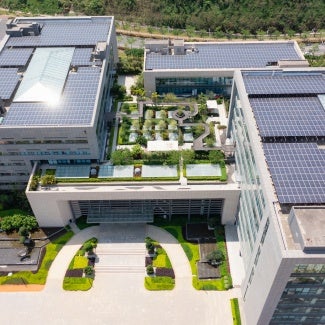How building materials affect our environment
Architects can reduce environmental impacts by choosing building materials wisely, addressing issues from ozone layer depletion to emerging challenges like embodied carbon reduction, climate change, and habitat loss.

Building materials impact
Virtually every building material choice architects make offers us an opportunity to reduce impacts on our planet’s environment. In many cases, the repercussions of our decisions are well-known, such as the effect on the ozone layer from CFCs and other gases. In others, like reducing embodied carbon, we’re only beginning to understand how we can make a difference in increasingly urgent environmental situations, such as climate change, ocean acidification, freshwater nutrient pollution, soil quality, and forest health, all of which result in resource depletion and habitat loss.
Carbon emissions & climate change
The built environment contributes significantly to human-caused carbon emissions, meaning that architects have an enormous opportunity to reduce carbon emissions and combat climate change through our work. We often focus on building design that will minimize or reduce operational carbon emissions; in addition to those vital efforts, we can also make material selections that bolster our progress toward carbon-neutral design through our materials choices. For instance, there are several strategies architects can use to reduce embodied carbon (the carbon emitted during the manufacture and transport of materials, and during the construction process) representing carbon reductions that can have an immediate, positive impact.
Protecting resources & biodiversity
Our materials have lasting effects on air, water, and land that can ripple through our environment affecting biodiversity and access to natural resources.
For example, the impact that materials can make on our oceans and freshwater sources is wide-ranging. They can range from localized issues, such as runoff or hazardous waste from a specific manufacturer entering a certain body of water. Other effects can be much broader including the effects of climate change. To demonstrate a ripple effect with this example, excess carbon emissions absorbed into the ocean causes the water to become more acidic (acidification) which dissolves coral skeletons causing reefs to collapse. Those reefs are hatcheries for countless species that impact the entire ecosystem. Losing those species can reduce the food supply all the way up to the top of the food chain, including the seafood we eat. This demonstrates the ripple of one effect on oceans, but other examples can be made for various impacts in every ecosystem from forests to plains and mountains to beaches.
Taking action
Fortunately, thanks to advocacy from our profession and others, there is an expanding arsenal of information and ideas to draw upon. This knowledge enables architects to better guide client decisions and effectively compare environmental outcomes alongside more typical cost, aesthetic, and performance measures.
Environmental Product Declarations
Environmental Product Declarations (EPDs), for instance, are comprehensive reports from manufacturers detailing the life cycle impact of a given material or product, from resource extraction and manufacturing to reuse or disposal. While only a handful of EPDs existed even just a few years ago, their development has accelerated, with more than a thousand now available.
Resource efficiency
Sometimes it’s not what we build, but what we don’t build that matters. Methods to use our building materials efficiently come in many flavors and sizes. These can range from product- to building-level solutions.
Carl Elefante, FAIA and 2018 AIA president-elect, is well-known for saying “the most sustainable building is the one that’s already built.” Adapting existing buildings and materials is probably the most beneficial approach to reducing a project’s impact on the environment, and often leads to a stronger connection with the community. Rehabilitating buildings and materials also gives depth and character to projects, along with a cultural link to the neighborhood or region. New buildings hold opportunities for rehabilitation too. Architects can consider future uses for current projects and designs with flexibility and adaptation in mind.
Incorporation of local, regional, and recycled products is ubiquitous within sustainable design and construction these days. Beyond that, practitioners can design to reduce waste by working with the modular units of building products (e.g., 4x8 gypsum board sheets) to reduce waste and maximize efficiency. Taking that a step further, zero-waste design principles promote using structural elements as finished surfaces, such as polished concrete and exposed beams. Greater attention to detail and precise specification, combined with few to no late design changes, also further reduces construction waste.
An expanding set of tools and strategies
The growing ubiquity of EPDs and resource efficiency are just a few positive results of our profession’s call for transparency, complementing other methods (e.g., forest certification or Whole Building Life-Cycle Assessments (LCAs), which incorporate EPDs and building reuse strategies) to evaluate environmental consequences. With the increasing availability of information and tools in this arena, architects who commit to learning more will empower themselves with a better understanding of their options to improve design while minimizing environmental impact.



